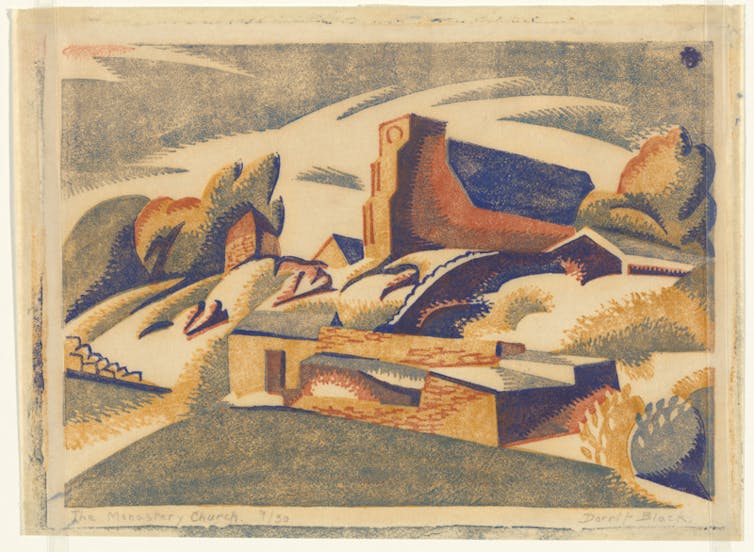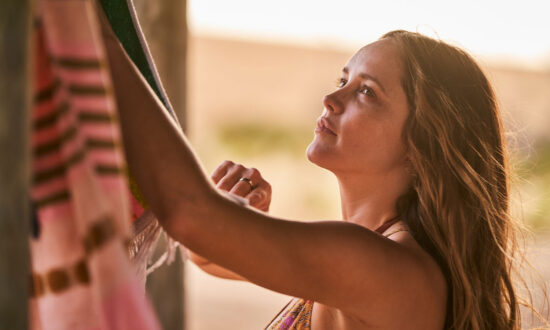Review: The Exhibitionists, ABC TV
What do you picture in your mind when you imagine an artist?
Is it a man in a beret? Do you think Pablo Picasso, Salvador Dali, Van Gogh? Odds are it is unlikely to be a woman. Yet there are many famous and highly regarded women artists: Frida Kahlo, Georgia O’Keeffe, Cindy Sherman.
It is even less likely for the word “artist” to trigger the image of an Australian woman. There are, however, many of importance to Australia’s cultural life: Emily Kame Kngwarreye, Tracey Moffatt, Patricia Piccinini and Margaret Preston among them.
Female artists are nowhere near as well known as their male counterparts.
A new docu-comedy, The Exhibitionists, explains why this dominant image of an artist is man, and describes many fascinating stories of the noteworthy place of women across the history of Australian art.
After a few too many drinks at an exhibition opening, four friends (played by Mandy McElhinney, Bridie Carter, Bessie Holland and Veronica Milsom) dare each other to get locked into the National Gallery of Australia (NGA). Having a bit of a lark, they notice there aren’t many female artists on show, and set about rectifying that. This narrative is used as a framing device for fascinating profiles of Australian women artists and interviews with experts.
Shaping art practice: the female gaze
The Exhibitionists defines the male gaze as “the idea that everything we look at is created for a default viewer who is male. It is men’s ideas, men’s needs, that dominate the creation of art and visual media”.
In contrast, this docu-comedy gives an insight into “the female gaze”, which I describe as “the individual way anyone who identifies as female inflects her own female experience or subjectivity” onto her artwork.
The female artists included in the program played a role in elevating female iconography and women’s culture. Through their work, they introduced crafts such as embroidery into the halls of fine art, and avoided exploitative representations of the female body.
Arguably, it was these things that led to their work being disregarded by gatekeepers and critics.
The Exhibitionists chronicles decades of misogynist critics whose point of view arguably worked to hold women out, an issue across most artforms.
In 1933, critic James Stuart MacDonald bemoaned the “tremendous intrusion of women painters since the war”.
As recently as 2008, Brian Sewell wrote in London’s Evening Standard that “only men are capable of aesthetic greatness”. He noted women are prevalent in art schools but tend to fade away – a fact that indicates systemic issues for female artists rather than a lack of talent.
Women artists are subjected to the same discrimination evident in many other fields, including a gender pay gap, under-representation in galleries, and unconscious bias — particularly by gatekeepers. For example, critics are still often white, heterosexual men over 40 with track records of lacking regard for women’s art.
#KnowMyName
The NGA, which assisted financing The Exhibitionists, has recognised that only 25 per cent of works in its Australian art collection are by women. This situation is mirrored in galleries nationally and internationally.
To redress this, the NGA launched an initiative called “Know My Name” in 2019, aiming to increase representation in the collection while celebrating and recognising Australian female artists.
The initiative has been a call to action and also made visible the work of women across diverse creative practices, highlighting the systemic issues that have been barriers to their participation.
This example of leadership by a cultural institution comes on the back of a long history of women’s activism to attain recognition.
Often this has been achieved through humour, as it does in The Exhibitionists.
Guerrilla Girls, an anonymous activist group, fight sexism and racism with humour. In 1989 they printed posters asking “Do women have to be naked to get into the Met museum?”, noting only 5 per cent of the modern art collection was from female artists, but 85 per cent of the nudes were of women.
Referring to that phenomena as “the male graze”, the Guerrilla Girls challenged people to count the nudes in other galleries and report back.
Brilliant artists
There are some shocking statistics in The Exhibitionists about how women have been held out of art world circuits, but of most interest are the stellar female artists across eras and styles.
The program creates a potted female-centred history of Australian art. Included is landscape painter Jane Sutherland (1853-1928), the first professional Australian female artist. She was a member of Heidelberg School and one of a small number of women who accompanied Frederick McCubbin and Tom Roberts on painting trips.
Emily Kame Kngwarreye (1910-1996) was one of Australia’s finest abstract expressionists, achieving the highest price for a painting by an Australian woman artist ($A2.1 million in 2017). She did this in sourcing her work from her clan country Alhalkere, and not from western art.
Dorrit Black (1891-1951) was the first Australian woman to run an art gallery and the first Australian cubist landscape painter.
It does appear that in order to make this contribution, many of these artists did not have families and devoted themselves to their art. This life choice led to them being regarded as unfeminine or unwomanly. However, along the way they made a substantive contribution to Australian art.
The Exhibitionists tells us women’s stories matter, and they attract audiences.
Art is for everyone, and it should mirror society.
The Exhibitionists screens on ABC TV on March 8 and is also available on ABC iView.
Lisa French is a Professor and Dean in the School of Media and Communication at RMIT University. This article is republished from The Conversation under a Creative Commons licence. Read the original article.
![]()
Support local arts journalism
Your support will help us continue the important work of InReview in publishing free professional journalism that celebrates, interrogates and amplifies arts and culture in South Australia.
Donate Here







